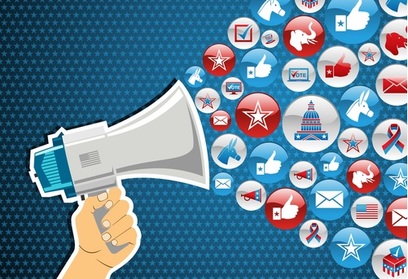Menu
|
2016: The first social-media election
|

Much has been written about the differences between Millennials and Baby Boomers. As the Presidential election nears, one generational variation sticks out: Where do you get your information about the election? A survey by the Pew Research Center released on February 4, 2016, indicates that cable news shows were named “most important” source of election news by 24 percent of the respondents, followed by social media and local TV news at 14 percent each, and news websites/apps at 13 percent.
For people age 18 to 29, social media was cited as most important by 34 percent of respondents, followed by news websites/apps (18 percent), cable news shows (12 percent), and radio (10 percent). For voters age 65 and older, cable news shows were the most important source of election news for 43 percent of respondents, followed by network nightly news (17 percent) and local TV (10 percent). Likewise, the 50-to-64 demographic cited cable news shows (25 percent), local TV (19 percent), and network nightly news (14 percent) as their most-important election news sources. As you might expect, social media was cited by far fewer older folks than younger ones as sources for election news: Only 5 percent of those age 50 to 64, and a miniscule 1 percent of those 64 and older. Another Pew Research Center study released at about the same time indicates a party difference among millennials who follow the election via social media. Those identifying as Democratic or Democratic leaning are much more likely to become active participants in the election (74 percent) than those calling themselves Republican or Republican leaning (50 percent). In an August 27, 2015, article, CIO’s Lauren Brousell claims that social media could decide the 2016 Presidential election. The candidates have had varying success with their social-media strategies, according to Brousell. In particular, it can be challenging for the campaigns to “control the message” because social media often changes the context – again, and again, and again. For example, in the last 24 hours, video of New Jersey Governor Chris Christie’s discomfort standing silently behind Donald Trump as the Republican front-runner spoke at the podium has evolved into a meme, as the New York Times’ Francis X. Clines reports in a March 2, 2016, article. Social-media politicking must be done very carefully to avoid sending the altogether wrong message. Brousell quotes an executive for a social media analytics company stating that millennials are marketed to like no other generation, and they know when their being marketed to. Politico’s Nicholas Carr examines the negative impact of social media on electioneering in a September 2, 2015, article. Carr calls social media the third great technology innovation affecting politics in the last century. In the 1920s, radio ushered in the age of intimacy between candidates and voters. Franklin Delano Roosevelt’s fireside chats were quiet, calming, and direct, which was the antithesis of the loud, bombastic stump speeches that characterized politicking previously. In the 1950s and 1960s, television took control of campaigns, favoring image over substance. Politicians from John F. Kennedy to Ronald Reagan to Bill Clinton polished their public personae, and the age of the celebrity politician arrived. Social media takes this to a new extreme by emphasizing personality over image. People want to vote for the candidate they would feel most comfortable sharing a beer with, according to Carr. However, social media’s greatest shortcoming as a political tool is its ephemeral and often hostile nature: “Social media favors the bitty over the meaty, the cutting over the considered. It also prizes emotionalism over reason. The more visceral the message, the more quickly it circulates and the longer it holds the darting public eye. In something of a return to the pre-radio days, the fiery populist now seems more desirable, more worthy of attention, than the cool wonk. It’s the crusty Bernie and the caustic Donald that get hearted and hash-tagged, friended and followed.” It reminds me of the old line about sincerity being the most important thing: “If you can fake that, you got it made!” |
